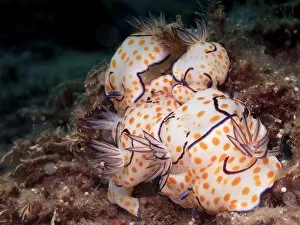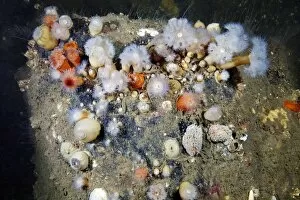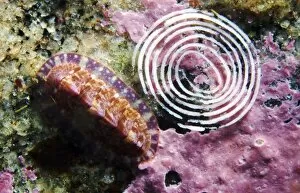Sea Slug Collection (page 5)
The mesmerizing world of sea slugs, also known as nudibranchs, is a kaleidoscope of vibrant colors and intricate patterns
All Professionally Made to Order for Quick Shipping
The mesmerizing world of sea slugs, also known as nudibranchs, is a kaleidoscope of vibrant colors and intricate patterns. Among them, the purple Janolus cristatus stands out in the crystal-clear waters surrounding Vela Luka on Korcula Island in Croatia's Adriatic Sea. With its delicate gills exposed and no protective shell, this species relies on toxic chemicals for self-defense. Venturing further to the Great Barrier Reef in Queensland, we encounter another fascinating creature - the Chromodoris coil. Unlike most snails, this nudibranch showcases its exquisite beauty without a shell while relying on toxic compounds to ward off potential predators. In North Sulawesi's Lembeh Strait lies an underwater paradise where Phyllidia marindica thrives. This stunning nudibranch captivates with its unique coloration and intricate markings against a backdrop of vibrant coral reefs. Delving into uncharted territory brings us face-to-face with newly discovered species like Doto greenamyeri found gracefully perched upon feather hydroids. These elusive creatures continue to amaze scientists as they unravel nature's secrets. A true marvel of nature unfolds before our eyes as we witness the Fingerprint Flamingo Tongue crawling over a sponge in Little Tobago, Trinidad and Tobago. Its striking pattern resembles that of a flamingo's feathers and serves as camouflage among its surroundings. Moving closer to home, we encounter Aeolidia papillosa alongside Snakelocks Anemone in shallow pools along rocky shores. The Common Grey Seaslug displays elegance amidst its natural habitat while showcasing an intimate connection between different marine organisms. Witnessing nudibranchs mating reminds us of their complex life cycles and reproductive strategies that contribute to their remarkable diversity. These captivating moments highlight not only their beauty but also their importance within marine ecosystems worldwide. A composite image reveals an awe-inspiring variety and abundance of tropical nudibranch species against a black background in the Indo-Pacific region.




















